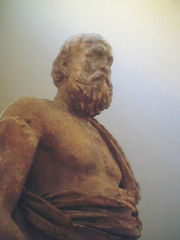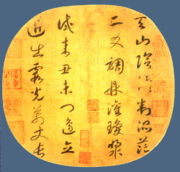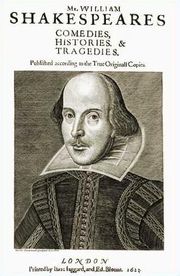Humanities
2007 Schools Wikipedia Selection. Related subjects: Education
The humanities are a group of academic subjects united by a commitment to studying aspects of the human condition and a qualitative approach that generally prevents a single paradigm from coming to define any discipline. The humanities are usually distinguished from the social sciences and the natural sciences and include subjects such as the classics, languages, literature, music, philosophy, the performing arts, religion and the visual arts. Other subjects at times included as humanities in some parts of the world include archaeology, area studies, communications, cultural studies and history, although these are often regarded as social sciences elsewhere.
Branches
Arts
The arts are usually considered as part of the humanities. These include visual arts such as painting and sculpture, as well as performing arts such as theatre and dance, and literature. Other humanities such as language are sometimes considered to be part of the arts, for example as the language arts.
Visual art
History
The great traditions in art have a foundation in the art of one of the ancient civilizations:
- Ancient Egypt,
- Greece and Rome,
- China,
- India, or
- Mesopotamia.
Ancient Greek art saw a veneration of the human physical form and the development of equivalent skills to show musculature, poise, beauty and anatomically correct proportions. Ancient Roman art depicted gods as idealized humans, shown with characteristic distinguishing features (i.e. Zeus' thunderbolt).
In Byzantine and Gothic art of the Middle Ages, the dominance of the church insisted on the expression of biblical and not material truths.
The Renaissance saw the return to valuation of the material world, and this shift is reflected in art forms, which show the corporeality of the human body, and the three-dimensional reality of landscape.
Eastern art has generally worked in a style akin to Western medieval art, namely a concentration on surface patterning and local colour (meaning the plain colour of an object, such as basic red for a red robe, rather than the modulations of that colour brought about by light, shade and reflection). A characteristic of this style is that the local colour is often defined by an outline (a contemporary equivalent is the cartoon). This is evident in, for example, the art of India, Tibet and Japan.
Religious Islamic art forbids iconography, and expresses religious ideas through geometry instead.
The physical and rational certainties depicted by the 19th-century Enlightenment were shattered not only by new discoveries of relativity by Einstein and of unseen psychology by Freud, but also by unprecedented technological development.
Increasing global interaction during this time saw an equivalent influence of other cultures into Western art.
Classics
The classics, in the Western academic tradition, refer to cultures of classical antiquity, namely the Ancient Greek and Roman cultures. Classical study was formerly considered one of the cornerstones of the humanities, but the classics declined in importance during the 20th century. Nevertheless, the influence of classical ideas in humanities such as philosophy and literature remain strong.
History
History is systematically collected information about the past. When used as the name of a field of study, history refers to the study and interpretation of the record of humans, families, and societies. Knowledge of history is often said to encompass both knowledge of past events and historical thinking skills.
Traditionally, the study of history has been considered a part of the humanities. However, in modern academia, history is increasingly classified as a social science, especially when chronology is the focus.
Languages and literature
The study of individual modern and classical languages form the backbone of modern study of the humanities, while the scientific study of language is known as linguistics and is a social science. Since many areas of the humanities such as literature, history and philosophy are based on language, changes in language can have a profound effect on the other humanities. Literature, covering a variety of uses of language including prose forms (such as the novel), poetry and drama, also lies at the heart of the modern humanities curriculum. College-level programs in a foreign language usually include study of important works of the literature in that language, as well as the language itself (grammar, vocabulary, etc.).
Performing arts
The performing arts differ from the plastic arts insofar as the former uses the artist's own body, face, presence as a medium, and the latter uses materials such as clay, metal or paint which can be molded or transformed to create some art object.
Performing arts include acrobatics, busking, comedy, dance, magic, music, opera, film, juggling, marching arts, such as brass bands, and theatre.
Artists who participate in these arts in front of an audience are called performers, including actors, comedians, dancers, musicians, and singers. Performing arts are also supported by workers in related fields, such as songwriting and stagecraft.
Performers often adapt their appearance, such as with costumes and stage makeup, etc.
There is also a specialized form of fine art in which the artists perform their work live to an audience. This is called Performance art. Most performance art also involves some form of plastic art, perhaps in the creation of props. Dance was often referred to as a plastic art during the Modern dance era.
- Music
Music as an academic discipline mainly focuses on two career paths, music performance (focused on the orchestra and the concert hall) and music education (training music teachers). Students learn to play instruments, but also study music theory, musicology, history of music and composition. In the liberal arts tradition, music is also used to broaden skills of non-musicians by teaching skills such as concentration and listening.
- Theatre
Theatre or theatre (Greek "theatron", θέατρον) is the branch of the performing arts concerned with acting out stories in front of an audience using combinations of speech, gesture, music, dance, sound and spectacle — indeed any one or more elements of the other performing arts. In addition to the standard narrative dialogue style, theatre takes such forms as opera, ballet, mime, kabuki, classical Indian dance, Chinese opera, mummers' plays, and pantomime.
Dance
Dance (from Old French dancier, perhaps from Frankish) generally refers to human movement either used as a form of expression or presented in a social, spiritual or performance setting.
Dance is also used to describe methods of non-verbal communication (see body language) between humans or animals ( bee dance, mating dance), motion in inanimate objects (the leaves danced in the wind), and certain musical forms or genres.
Choreography is the art of making dances, and the person who does this is called a choreographer.
Definitions of what constitutes dance are dependent on social, cultural, aesthetic artistic and moral constraints and range from functional movement (such as Folk dance) to codified, virtuoso techniques such as ballet. In sports, gymnastics, figure skating and synchronized swimming are dance disciplines while Martial arts ' kata' are often compared to dances.
Religion and philosophy
Most historians trace the beginnings of religious belief to the Neolithic Period. Most religious belief during this time period consisted of worship of a Mother Goddess, a Sky Father, and also worship of the Sun and the Moon as deities. (see also Sun worship)
New philosophies and religions arose in both east and west, particularly around the 6th century BC. Over time, a great variety of religions developed around the world, with Hinduism and Buddhism in India, Zoroastrianism in Persia being some of the earliest major faiths.
In the east, three schools of thought were to dominate Chinese thinking until the modern day. These were Taoism, Legalism, and Confucianism. The Confucian tradition, which would attain predominance, looked not to the force of law, but to the power and example of tradition for political morality. In the west, the Greek philosophical tradition, represented by the works of Plato and Aristotle, was diffused throughout Europe and the Middle East by the conquests of Alexander of Macedon in the 4th century BC.
Abrahamic religions are those religions deriving from a common ancient Semitic tradition and traced by their adherents to Abraham (circa 1900 BCE), a patriarch whose life is narrated in the Hebrew Bible/ Old Testament, and as a prophet in the Quran and also called a prophet in Genesis 20:7. This forms a large group of related largely monotheistic religions, generally held to include Judaism, Christianity, Islam, and the Bahá'í Faith, and comprises about half of the world's religious adherents.
History of the humanities
In the West, the study of the humanities can be traced to ancient Greece, as the basis of a broad education for citizens. During Roman times, the concept of the seven liberal arts evolved, involving grammar, rhetoric and logic (the trivium), along with arithmetic, geometry, astronomia and music (the quadrivium). These subjects formed the bulk of medieval education, with the emphasis being on the humanities as skills or "ways of doing."
A major shift occurred during the Renaissance, when the humanities began to be regarded as subjects to be studied rather than practised, with a corresponding shift away from the traditional fields into areas such as literature and history. In the 20th century, this view was in turn challenged by the postmodernist movement, which sought to redefine the humanities in more egalitarian terms suitable for a democratic society.
Humanities today
Humanities in the United States
Many American colleges and universities believe in the notion of a broad "liberal arts education", which places an emphasis on all college students studying the humanities in addition to their specific area of study. Prominent proponents of liberal arts in the United States have included Mortimer J. Adler and E.D. Hirsch.
The 1980 United States Rockefeller Commission on the Humanities described the humanities in its report, The Humanities in American Life:
Through the humanities we reflect on the fundamental question: What does it mean to be human? The humanities offer clues but never a complete answer. They reveal how people have tried to make moral, spiritual, and intellectual sense of a world in which irrationality, despair, loneliness, and death are as conspicuous as birth, friendship, hope, and reason.
Criticism of the traditional humanities/liberal arts degree program has been leveled by many that see them as both expensive and relatively "useless" in the modern American job market, where several years of specialized study is required in many/most job fields. This is in direct contrast to the early 20th century when approximately 3% to 6% of the public at large had a university degree, and having one was a direct path to a professional life.
After World War II, many millions of veterans took advantage of the GI Bill. Further expansion of federal education grants and loans have expanded the number of adults in the United States that have attended a college or university to be at least 60% of the population. As a consequence, degrees in such things as literature, art history, classics, etc, are no longer viewed as viable career path options by many. As a result, many graduates find themselves returning to school to earn another degree or waiting much longer than average to kick off their career successfully.
Meanwhile, there are many changes and debates occurring today in the humanities:
Questioning distinctions
The very concept of the ‘humanities’ as a class or kind, distinct from the ’sciences’, has come under repeated attack in the twentieth century. T.S. Kuhn’s The Structure of Scientific Revolutions argued that the forces driving scientific progress often have less to do with objective inference from unbiased observation than with much more value-laden sociological and cultural factors. More recently, Richard Rorty has argued that the distinction between the sciences and the humanities is harmful to both pursuits, placing the former on an undeserved pedestal and condemning the latter to irrationality. Rorty’s position requires a wholesale rejection of such traditional philosophical distinctions as those between appearance and reality, subjective and objective, replacing them with what he endorses as a new ‘fuzziness’. This leads to a kind of pragmatism where" the oppositions between the humanities, the arts, and the sciences, might gradually fade away... In this situation, ‘the humanities’ would no longer think of themselves as such...."
Modernism and postmodernism
In the United States, the late 20th century saw a challenge to the "elitism" of the humanities, which Edward Said has characterized as a "conservative philosophy of gentlemanly refinement, or sensibility." Such postmodernists argue that the humanities should go beyond the study of " dead white males" to include work by women and people of colour, and without religious bias. The French philosopher Michel Foucault has been a very influential part of this movement, stating in The Order of Things that "we can study only individuals, not human nature."
However some in the humanities believe that such changes may be detrimental, as they lead to moral relativism and the concept that one person's interpretation is as good as any other. The literary critic Denis Donoghue suggests that modern criticism reduces the rich symbolism of a play like Macbeth to a simplistic "find the villain", with Lady Macbeth regarded as the victim of bloody-minded, power-mad masculine society; the result is said to be what E. D. Hirsch Jr. refers to as declining cultural literacy.
The modernist considers that there is a canon of "great works" in literature and art which have an inherent quality, but the postmodernist argues that such ideas of greatness have been heavily biased by gender and culture. The modernist advocates close reading of a few works in literature, but the postmodernist generally favors more "extensive reading" of a large variety of works.
National institutions
President Lyndon Johnson signed the National Foundation on the Arts and Humanities Act in 1965 , creating the National Council on the Humanities and funded the National Endowment for the Humanities (NEH) in 1969. NEH is an independent grant-making agency of the United States government dedicated to supporting research, education, preservation, and public programs in the humanities.
NEH facilitated the creation of State Humanities Councils in the 56 U.S. states and territories. Each council operates independently, defining the "humanities" in relationship to the disciplines, subjects, and values valued in the regions they serve. Councils give grant funds to individuals, scholars, and nonprofit organizations dedicated to the humanities in their region. Councils also offer diverse programs and services that respond to the needs of their communities and according to their own definitions of the humanities.
Humanities in the digital age
Language and literature are considered to lie at the heart of the humanities, so the impact of electronic communication is of great concern to those in the field. The immediacy of modern technology and the internet speeds up communication, but may threaten "deferred" forms of communication such as literature and "dumb down" language. The library is also changing rapidly as bookshelves are replaced by computer terminals. The humanities will have to adapt rapidly to these changes, though it is unlikely that the traditional pen and paper will disappear altogether.
Terminology
- Scholars working in the humanities are sometimes described as humanists. But that term also describes the philosophical position of humanism, which some antihumanist scholars in the humanities reject.




